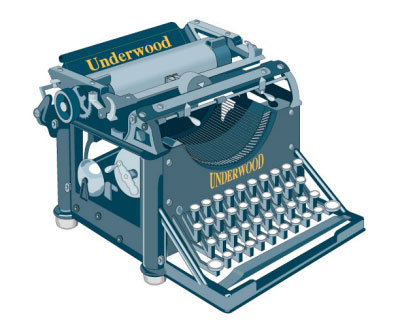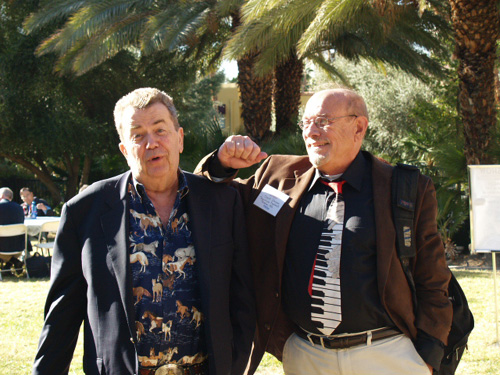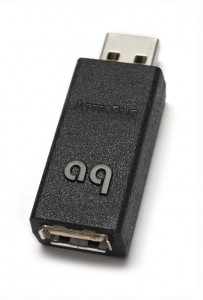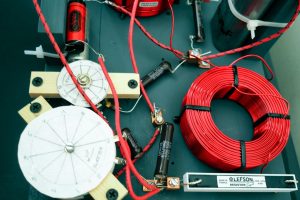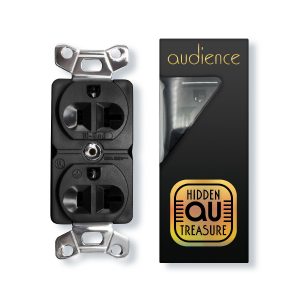
More than once this writer has been accused of having a single-track mind when it comes to talking audio. This view I must heartily confute: in fact he has three tracks. But the one that attracts attention foremost does concern polarity, also known as acoustic polarity, also under proper circumstances known as Absolute Polarity. On this topic I have written two earlier columns, performed research that resulted in a paper delivered to the Audio Engineering Society, and published a book, The Wood Effect: Unaccounted Contributor to Error and Confusion in Acoustics and Audio.
So it's a timeworn track, if not exactly a single-minded one. And yet, and yet, despite all this effort little has changed as a result. You might think that people, once alerted by the above work, would truly heed the late Dr. Richard Heyser's bracing injunction in AudioMagazine for (as long ago as) September, 1979:
I propose that the polarity convention of every part of the audio chain be identified and this information made available to establish the net polarity of the reproduced sound relative to the original performance… There is truly no aspect of the audio industry that lies apart from this first step into providing information relating to better sound. [Emphasis added.]
His exemplary speech, entitled "Polarity Convention", continued thusly:
I propose that from this point forward the entire audio industry take a basic step which is capable of improving the quality of the listening experience without adding any cost to that product… With constant improvement in audio systems we have now reached the state where many persons can readily perceive the coloration caused by improper polarity in the reproduced sound…Aware of the distinct audibility of polarity, I have since 1974 measured and provided a standard for the phase reference of loudspeaker reproduction, the so-called absolute phase. I now publically call upon the entire audio industry, from computer composer through loudspeaker and headphone manufacturer, to acknowledge polarity as a psycho-acoustic parameter and identify the polarity convention of their product.
But that was not to be. Hence we have this further article, delivered here with a sort of deathbed finality: It's now or never, because I may give up on the damn thing after this. Know, however, that entirely new information will be presented below that helps explain the ongoing confusion, including data that I can almost guarantee no one had ever thought to see. I might add that certain people will find this newly-revealed state of affairs very unpleasant indeed, so don't touch that clicker.
Newcomers to Polarity do deserve some introduction though, which for the sake of everyone else I shall make brief. The abstract to The Wood Effect (1988) still explains it best:
Masked by random combination with other distortions in the music reproduction chain, an unsuspected major contributor has lain hidden: Aural sensitivity to "phase inversion", the Wood effect.
Musical instruments normally create compression waves in their attack transients. Electronics, however, often invert that natural, positive polarity to negative, unnaturalrarefaction as emitted from loudspeakers, thus diminishing physical and aesthetic impact. The term Absolute Polarity uniquely describes the correct arrival to the ear of acoustic wavefronts from loudspeakers, with respect to actual musical instruments.
Wrong polarity, when isolated, is obvious to almost everyone. Its present neglect results primarily from habitual disregard for linear phase response in loudspeakers, due largely to the erroneous auditory theory of Helmholtz.
Results of an extensive study of the polarity phenomenon are reported and discussed, including an exhaustive survey of the relevant literature. Although no means are proposed to correct countless errors, customary practice in acoustics and audio is severely scrutinized.
While the book explores every recognized aspect (and I can moreover confidently state it will never be superseded), and is still available (1), an early column of mine in this magazine covers considerable ground. Any curious tyro will find it helpful: HERE
I should also add that on Audio Asylum boards in the previous decade I vigorously defended the principle against a barrage of bullheaded skeptics. A site search will reveal all, for those interested in following such activity. An even more acrimonious and vacuous assault occurred on gearslutz.com, a forum for mastering engineers, and even if I do say so myself the defense I mounted resulted in some of my best (and very polite as well) argumentation ever. [Regrettably the editors here discourage my quoting the repartee at all extensively, even the parts I wrote.]
Go to HERE to feel the heat.
On another, similar location, the Steve Hoffman Forum, one finds mannerly, nonrancorous acknowledgement of the facts. Find that HERE
Now to the promised news
The preeminent finding in The Wood Effect was the "polarity split", the fact that all recorded media (LP records, CDs, cassettes, even 78s) throughout the decades have been split overall between the two possible inscribed polarities by exactly 50/50. How could this be? Clearly through lack of control over this vital aspect of recorded material that can only have resulted from the blithe dismissal throughout the industry of the acute audibility of Polarity, Dr. Heyser notwithstanding.
A corollary finding was that some LPs and most CDs at that time exhibited a fascinatingly anomalous behavior, viz. that tracks or cuts would actually alternate in polarity. Those LPs were mostly from Japan although the affected CDs originated from all over. This came as a revelation: that certain agencies in the industry did know! And had evidently developed automatic means to detect and systematize polarity to produce discs and records that because of the admixture could be enjoyed more or less throughout, on any system of indeterminate but fixed polarity, with no one the wiser to the subterfuge. (This particular claim has been repeatedly challenged, but facts are facts.)
This brings us to the vexed question of, how does one know what's right? At the front line we have the self-trained ear, but surely there must be electronic devices that can sense Absolute Polarity while the music's playing? Indeed there is one that detects the signals issuing from a loudspeaker, and used judiciously it indicates in or out (SMART System 2000 Sound Check). But to calibrate one's home system and find which polarity it's set to, most people use a test disc with a polarity check on it.
But here's the thing. An evaluation of every such disc in my collection reveals the polarity split happening again! Although not 50/50, but bad enough.
You heard that right. Inconsistency galore! Because they vary so, no single test disc may be relied upon to divulge a system's fixed polarity.
The proof data follow shortly, but now another surprising finding. With the five different CD players available to me at the time of this discovery (the late nineties), all set to what the manufacturers termed "+" or "Positive" or "Normal" polarity, three of them conformed to one polarity and the other two to the other. That may be better than a 50/50 split, but nevertheless one hesitates to accept a majority decision on such a matter.
This all goes to show how polarity confusion (and even outright denial) may creep into otherwise rectitudinous audio practice. What brands all those players were is at this point moot, but one must wonder, how do the manufacturers themselves determine the output polarity of their devices? Not, one hopes, with a random one of those so-called test CDs. Surely not!
A case in point
Let's consider two of the otherwise-highest-performing players/converters in the aforementioned survey, a Meitner and a Vimak. Both designers are (or were, in the case of Vimak) known to me personally as bright, highly competent guys who are very fastidious about their work. Yet there their two machines were, delivering opposite polarities when set on the "+" position. What to think?
So I spoke to Edmund and Mike about this difficulty. Each, as would be expected, swore to his own player's correctness, because each had used the expensive and highly-regarded CBS Labs calibration disc. Huh! Well that got me to thinking and the only logical explanation I could conceive was that the CBS disc must have undergone a re-pressing with the polarity inadvertently reversed, because who pays attention to polarity? And anyway, none of the other calibration tracks would have been affected (frequency response, levels, etc) so no one at CBS Labs noticed.
I never invested my own limited funds in a CBS Labs disc, because which one would I have gotten?
Now before we get to the promised data, and in light of the above, every disc surveyed herein may have similarly gone through reissue and be today of a different polarity character than described. Therefore I offer my collection to anyone who wishes to disagree with my findings, for proof that my readings of polarities as they stood at the time are reliable.
And now a stumbling block, perhaps
When The Listening Studio, my place of research and business, closed its doors in 2000 and everything got moved into storage or into my house, things became very untidy. I'm talking 30,000 records and discs that had been there, partially combined with the 10,000 already at home. Several items got lost or misplaced, including, apparently, sadly, two of the five relevant test CDs. So there you have it. Regrettably I did not take written notes, instead only leaving indications on the program booklets.
So here are the findings that remain, although the rest as best I can recall mirror those below.
Chesky Records Jazz Sampler & Audiophile Test CD Vol. 1, ©1990, mastered by Bob Katz. (2)
Absolute Polarity Tests: Band 14 "Normal Polarity". Band 16 "Inverted Polarity"
Let's call the first one "N" for normal and the second "I" for inverted. In that case, the CD's nine select musical tracks, which alternate in their inscribed polarity, begin with an "I" and finish likewise, which gives, ironically, a 5:4 preference for "Inverted". But moving along:
Epiphany Recordings Concert and Test Sampler, ©1995
Absolute Polarity Test: "Correct polarity" - corresponds to "N" above. "Reversed polarity" - corresponds to "I" above.
Also there's a "Direct Current Absolute Polarity Diagnostic" intended for the user to determine the fixed polarity of his system. But this diagnostic strays too far afield and therefore is not included here.
BUT:
Presenting the Sheffield A2TB Test Disc, Track 24, "Positive Polarity" corresponds to "I" above.
Further to confuse the situation are the first two Stereophile Test CDs, neither of which includes a polarity test proper. However: CD Number One presents a mishmash of polarities on the music tracks, albeit mostly in alternation, while Number Two strictly alternates polarities in tracks 4 through 14.
How's a person supposed to decide what's right?
That's easy! Just listen. Music played in the wrong polarity introduces what I call the muffling distortion.
But what's a manufacturer supposed to do, whether one of players or CDs, given the absurd divergence among available reference test sources?
Aye, there's the real rub.
Then, what about these newfangled downloads, and streaming? Yeah!
(to be continued)
(1) The Wood Effect is available in limited quantities from the author – [email protected] $12 postpaid. Paypal accepted.
(2) Bob Katz wrote, in the aforementioned gearslutz thread: Don't go crazy on me. The CD is NOT ["cut in either polarity willy-nilly" as Clark wrote]. It has an absolute standard… If a recording has been carefully checked to be in correct polarity, then it will reproduce in correct polarity. The standard is there… Don't go crazy on me with discussion of random polarities on different albums. I'm not even sure what you are driving at and it doesn't matter a hoot. If there are random polarities on the recording, it's the recording engineer's fault, not the reproduction equipment.
Clark comments: No one's blaming you or yours, Mr. Katz. All I'm saying is that any recording after it leaves your shop somehow has this polarity alternation scheme imposed upon it without your knowledge. As for "correct polarity", no such thing exists in the groove or on the digital data. "Standards" and results vary tremendously, as I've ascertained.





